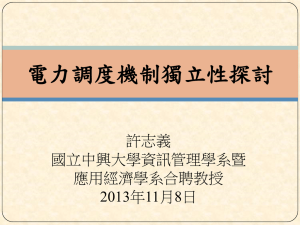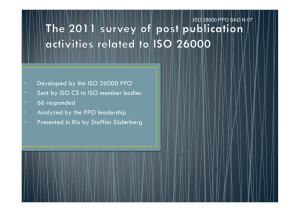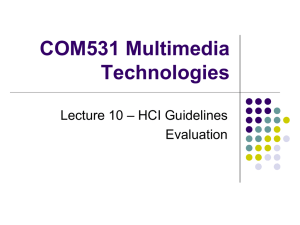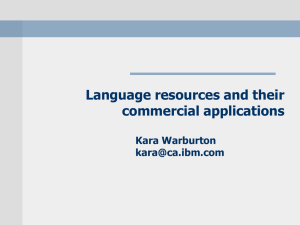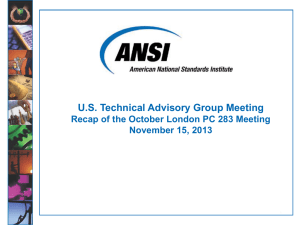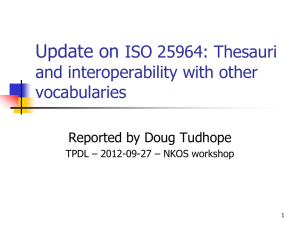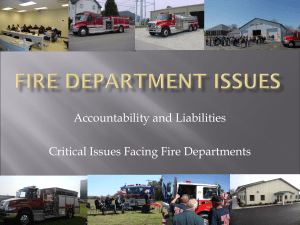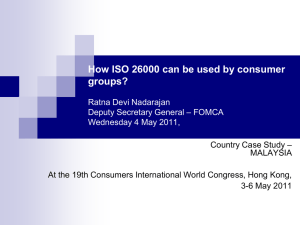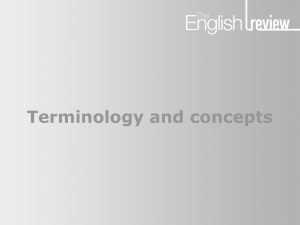Terminology_Tutorial..
advertisement
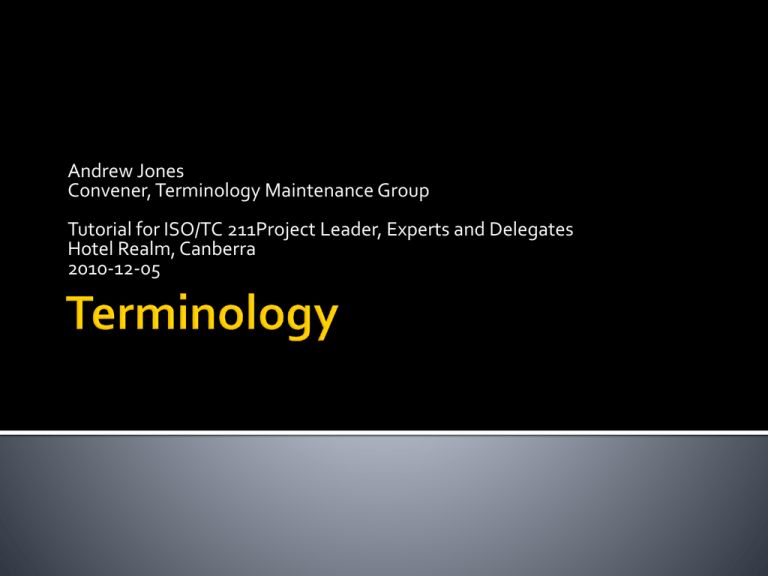
Andrew Jones Convener, Terminology Maintenance Group Tutorial for ISO/TC 211Project Leader, Experts and Delegates Hotel Realm, Canberra 2010-12-05 Introduction Concepts, terms and definitions Relevant standards and technical specifications Principles and methods Components of a terminology record Terminology Working Group Terminology spreadsheet Multi-lingual considerations A common language is an essential prerequisite to effective communication. A word can have several meanings depending on the context in which it is used. A concept can be referenced by several words, each communicating a different connotation or level of emphasis. Necessary to understand the subject’s terminology and the context in which it is to be used. Imprecise or ambiguous use of terminology (e.g. using two terms interchangeably when they have distinctly different connotations) can have unintended consequences. Concepts are central to terminology work Concept - unit of knowledge created by a unique combination of characteristics [ISO 1087-1:2000] Term - verbal designation of a general concept in a specific subject field [ISO 1087-1:2000] Definition - representation of a concept by a descriptive statement which serves to differentiate it from related concepts [ISO 1087-1:2000] NOTE: A term identifies a concept A definition describes a concept A definition does not describe a term or other designation Ultimate objective is to obtain a normative vocabulary in which only one term corresponds to one concept and only one concept corresponds to one term [ISO 10241]. Publish as an international terminology standard (e.g. ISO 1087-1 Terminology work – Vocabulary – Part 1:Theory and application)or a clause on terms and definitions in a subject standard (e.g Clause 4 in the ISO 191xx standards). ISO/TS 19104:2008 Geographic Information – Terminology ISO 10241:1992 International terminology standards — Preparation and layout ISO 704:2009, Terminology work — Principles and methods ISO 860:2007, Terminology work — Harmonization of concepts and terms ISO/TR 24156 Guidelines for using UML notation in terminology work Provides the guidelines for collection and maintenance of terminology in the field of geographic information. Establishes criteria for selection of concepts to be included in other standards concerning geographic information developed by ISO/TC 211, Specifies the structure of the terminological record Describes the principles for definition writing. Includes the following as normative references ISO 10241:1992 International terminology standards — Preparation and layout ISO 704:2009, Terminology work — Principles and methods Apply uniform principles and methods to terminology work. Six steps Establish a term list Refine the term list Establish concept fields Establish concept systems Formulate definitions Coin and select terms Identify the concepts that belong to the subject field. Include any term or concept description which seems relevant (even though it may later be deleted). If a definition, but no term, is found for a given concept, note the definition (with any supporting information). use a five-dot symbol (.....) to show that no term exists or has been found. Extract all information from each source in a single operation. Include concepts that require definition to aid the clarity of an ISO/TC 211 geographic information document. Include only concepts that are central to the understanding of the standard and are not self-explanatory. Include only concepts having a single definition. Don’t include a concept if its definition in general language dictionaries corresponds to its definition in the field of geographic information. Note- the term must not be a trademark, protected trade name, name of research project, or colloquial term (e.g. “guy” instead of “man”). Terms that appear in general language dictionaries may have specific meaning in a specific field Example The terms ‘necessary’ and ‘sufficient’ are general language terms They are also legal terms identifying specific legal concepts (see ISO 19153) Necessary - capable of recognizing and properly acting upon all legitimate requests, as defined by the requirements of the system Sufficient - capable of enforcing the requirements of a system The term list may include terms for concepts specific to the subject field; concepts common to several subject fields; borrowed concepts; general language concepts. The general classification of the subject field may serve as a guide to determine whether or not a given concept shall be included. The final vocabulary shall include terms for the specific concepts of the subject field; only a limited number of borrowed concepts and concepts common to several subject fields. After the term list has been established, arrange related concepts into concept fields. Concept field - unstructured sets of thematically related concepts Establish relations between concept fields Structure the concepts within each field into concept sub-systems so that each concept is allocated a specific place in the system. Concept systems shall be established in accordance with IS0 704. Concept fields provide a starting point for establishing concept systems . It is essential to determine which concepts are so basic and familiar that they need not be defined. Before drafting a definition for a concept, it is necessary to: determine the relations between the concept and its related concepts; and model a concept system within which the concept is situated. The concept system should directly mirror any UML representation included in the standard or technical specification Note also ISO/TR 24156 Guidelines for using UML notation in terminology work The concept system shall be worked out for each language, taking into consideration, if possible, national systems, different organizations, different schools of thought, etc. When this work has been completed, the following checks shall be made: Is the position of each concept correct? Are any concepts missing? The principles for definition writing are given in ISO 704 and included in ISO/TS 19104:2008 Annex C When drafting a new definition, use basic concepts or concepts defined elsewhere in the document as far as possible. Standardized definitions shall be used whenever possible. Don’t ‘reinvent the wheel’. Example – metadata Defined by ISO/19115:2002. Included in 11 standards ▪ “data about data” A draft document in 2009 proposed ▪ “model that defines the language for expressing other models” NO!!!!!!!!!!!! Use the most current version of the definition. WARNING ▪ Old versions may persist in unrevised documents ▪ Be sure to check the currency of the terminology record Example – coordinate reference system ▪ In ISO 19111:2003 ▪ “coordinate system that is related to the real world by a datum” ▪ In ISO 19111:2007 ▪ “coordinate system that is related to an object by a datum” Use the definition in ISO 19111:2007 An existing definition shall only be adopted without change if it reflects the concept system in question, otherwise it shall be adapted. Where a standardized definition in another field has to be adapted, an explanation shall be given in a note. When adapting a definition, include a reference to the parent standard (E.g. Adapted from ISO/IEC TR 10000-1:1998 Part 1) When using a definition that has already been adapted, include a reference to the standard where the adaption took place (E.g. ISO 19106:2004) Example – profile In ISO/IEC TR 10000-1:1998 Part 1 ▪ A set of one or more base standards and/or ISPs, and, where applicable, the identification of chosen classes, conforming subsets, options and parameters of those base standards, or ISPs necessary to accomplish a particular function. In ISO 19106 ▪ set of one or more base standards or subsets of base standards, and, where applicable, the identification of chosen clauses, classes, options and parameters of those base standards, that are necessary for accomplishing a particular function A definition shall describe only one concept. Don’t include hidden definitions for concepts used to identify characteristics. A definition should not contain characteristics that belong logically to superordinate or subordinate concepts. The extension and the characteristics reflected in a definition shall be appropriate to the concept system in a given subject field. Any characteristic that requires an explanation shall be defined separately as a concept or given in a note. Example – Generalization Proposed definition taxonomic relationship between a more general element and a more specific element. The more specific element is fully consistent with the more general element and contains additional information Supported definition taxonomic relationship between a more general element and a more specific element. NOTE An instance of the more specific element may be used where the more general element is allowed. See: inheritance. If the specific field of the concept is not clearly indicated in the term or is not generally understood, it shall be added to the beginning of the definition. Example cycle ▪ ⟨geometry⟩ spatial object without a boundary A definition shall reflect the concept system. Definitions shall be co-ordinated so as to be able to reconstruct the concept system. The characteristics used in the definition should be selected to indicate the connection between the concepts or the delimitation that distinguishes one concept from another. Example coordinate system ▪ set of mathematical rules for specifying how coordinates are to be assigned to points coordinate reference system ▪ coordinate system that is related to an object by a datum ellipsoidal coordinate system ▪ coordinate system in which position is specified by geodetic latitude, geodetic longitude and (in the three dimensional case) ellipsoidal height A definition shall describe the content of the concept precisely. Neither too narrow nor too broad. Describe what a concept is, not what it is not. Definitions shall be as brief as possible and as complex as necessary. Complex definitions can contain dependent clauses. Carefully written definitions contain only that information which makes the concept unique. Any additional descriptive information deemed necessary should be included in a note. Example - literal value Proposed definition ▪ a constant, explicitly specified, value rather than one that is determined by resolving a chain of substitution (e.g. a variable) Accepted definition ▪ constant, explicitly specified value NOTE This contrasts with a value that is determined by resolving a chain of substitution (e.g. a variable) Example - feature event Proposed definition ▪ information about the occurrence of a located feature along a locating feature which describes where along the locating feature the located feature occurs and optionally further qualified with the instant in, or period of, time during which this occurred Accepted definition ▪ information about the occurrence of a located feature along a locating feature NOTE 1 A feature event includes the linearly reference location of the located feature along the locating feature. NOTE 2 A feature event may be qualified by the instant in which, or period during which, the feature event occurred. Preferred structure: Basic part stating the class to which the concept belongs, Further part enumerating characteristics that distinguish the concept from other members of the class. Definitions shall not: be given in full-sentence form. begin with an article. begin with expressions such as “term used to describe...” or “term denoting...”, neither shall they take the form “term is...” or “term means...”. Example - Multipurpose Internet Mail Extensions (MIME) type Proposed Definition ▪ A MIME type specifies the media type and subtype of data in the body of a message and fully specifies the native representation (canonical form) of such data Accepted Definition ▪ media type and subtype of data in the body of a message that designates the native representation (canonical form) of such data Example – server Not ▪ a particular instance of a service But ▪ particular instance of a service Don’t begin with expressions such as “term used to describe...” or “term denoting...”, neither shall they take the form “term is...” or “term means...”. Example - element <XML> In CD 19142 ▪ an information term in the XML information Set In ISO 19136 ▪ basic information item of an XML document containing child elements, attributes and character data Definitions shall have the same grammatical form as the term; to define a verb, a verbal phrase shall be used; to define a singular noun, the singular shall be used. Example - verbal phrase geopositioning ▪ determining the geographic position of an object Example – singular noun coordinate ▪ one of a sequence of n numbers designating the position of a point in n-dimensional space Definitions shall be lower case, including the first letter, except for any upper-case letters required by the normal spelling of a word in running text. References to other entries in the vocabulary shall be indicated by using a preferred term defined elsewhere in the vocabulary. References to standardized definitions shall be presented within square brackets after the definition. The substitution principle shall be used to test the validity of a definition. A definition is valid if it can replace a designation in the text without loss of, or change in, meaning. Avoid Circular Definitions A definition is circular within a system of definitions when two or more concepts are defined by means of each other. The substitution principle clearly reveals repetition and circularity. See IS0 704:1987, clause 5, for the coining of terms. If there are synonyms, it is recommended that only one term be selected as the preferred term. In exceptional cases, selecting more than one term may be unavoidable. The non-preferred terms shall be specified as admitted, deprecated, obsolete, or superseded terms. Described in ISO/TS 19104:2008 Clause 7.1 Described more generally in ISO 10241:1992 Annex A Entry number Usually the clause identifier Preferred term Definition if taken from another normative document, a reference shall be added in square brackets after the definition; if referring to another concept in the vocabulary, that concept shall be named by its preferred term and presented in bold face characters. 4.1.11 direct position position described by a single set of coordinates within a coordinate reference system [ISO 19107:2003] 4.1.17 framework relationship between the elements of the content model and the separate encoding and portrayal mechanisms Abbreviation if preferred, the abbreviation shall precede the full form, otherwise an abbreviated form shall follow the full form. Admitted term(s) if these are national variants, they shall be followed by a code as defined in ISO 3166-1. Deprecated or obsolete terms in alphabetical order References to related entries Examples of term usage Notes may be used to provide additional information or context may vary from standard to standard 4.1 feature abstraction of real world phenomena [ISO 19101] EXAMPLE The phenomenon named ‘Eiffel Tower’ may be classified with other similar phenomena into a feature type ‘tower’. NOTE A feature may occur as a type or an instance. Feature type or feature instance should be used when only one is meant. 4.25 geodetic latitude ellipsoidal latitude ϕ angle from the equatorial plane to the perpendicular to the ellipsoid through a given point, northwards treated as positive Mandatory Fields Beginning date of the instance Term instance status Instance status code Status type 1 Candidate 2 Draft 3 Harmonized 4 Normative 5 Normative/Conflict 6 Deleted Optional Fields Ending date of the instance Described in Annex A of ISO/TS 19104 Substantive members include: The Convener All Working Group leaders A member of each project team (preferably the editor) A member of each national body participating in the MultiLingual Glossary of Terms In addition: A liaison from each spatial community of interest that engages in terminology cross-mapping initiative with ISO/TC 211 Combines the terminology clauses from the various ISO 19100-series standards into a single table of information A working document – subject to constant change Should be an integral part of the standards development processes The development of new concepts should take place at an early stage Terms and definitions identify and describe concepts – they may be important to parallel projects An aim of an international terminology standard is to harmonize the concepts, concept systems and the terms of different languages. In international terminological standardization, the definitions of the concepts shall be given in the official language(s) of the standardizing organization concerned; the definitions given in the official languages shall be equivalent in content; when possible, similar structures shall be used in their formulation; any differences between the concept system of the International Standard and the concept systems of the nonofficial languages shall be stated. Initiated in 2007 Based on ISO 19135:2005 Recognises each member country as the ultimate authority regarding the correct use and interpretation of its national language(s). Assigns responsibility to each country for implementing appropriate quality assurance procedures to ensure that each concept is interpreted correctly. Each national body is a submitting organization and is responsible for: The translation of the Glossary into its national language; The implementation of appropriate quality assurance procedures to ensure that the concept has been interpreted correctly; The provision of the appropriate authorisation to allow the translated terms to be published on the ISO/TC 211 Web site. Advising ISO/TC 211 of any changes to the translation of a term. In instances where a literal translation of an English term and/or definition is impractical or unsatisfactory, an equivalent national language term and /or definition may be substituted. The key consideration must be to ensure that the equivalent term/definition fully, completely and sensibly describes the concept represented by the English term/definition. Not mandatory that the entire Glossary be translated. Each member country may translate as much or as little of the Glossary as they consider necessary for their national purposes or to satisfy regional obligations. There is no specific timeframe for national bodies to complete the initial translation activity. Governed by the business priorities of each member country. In some instances, it may be desirable to link a picture or other graphic to the term record to illustrate the concept being defined.

